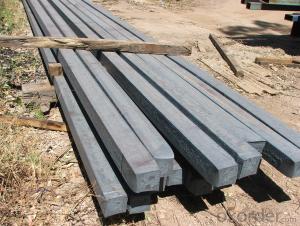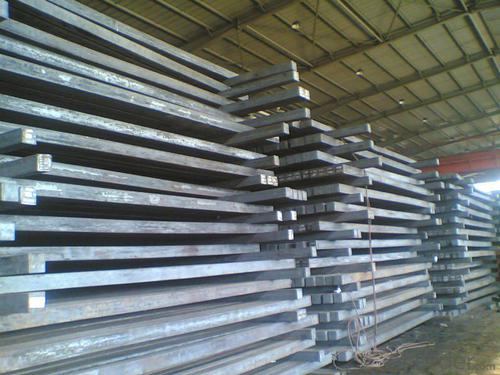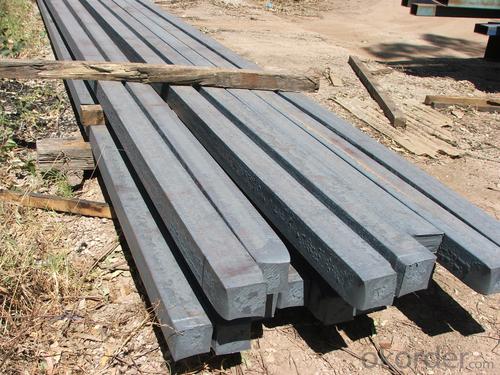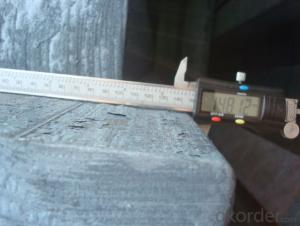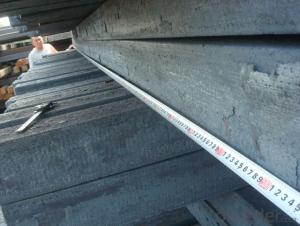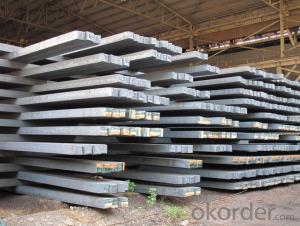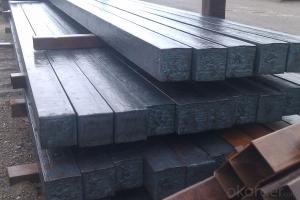Prime quality square alloy steel billet 175mm Q235
- Loading Port:
- Tianjin
- Payment Terms:
- TT OR LC
- Min Order Qty:
- 100 m.t.
- Supply Capability:
- 10000 m.t./month
OKorder Service Pledge
OKorder Financial Service
You Might Also Like
Structure of Prime quality square alloy steel billet 175mm Q235

Description of Prime quality square alloy steel billet 175mm Q235
1. Prepainted steel coil is coated with organic layer, which provides higher anti-corrosion property and a longer lifespan than that of galvanized or galvalume steel sheets.
2. The base metals for prepainted steel coil consist of cold rolled, HDGI Steel, electro-galvanized and hot-dip alu-zinc coated steel. The finish coats of prepainted steel coil can be classified into groups as follows: polyester, silicon modified polyesters, polyvinylidene fluoride, high-durability polyester, etc.
3. The production process has evolved from one-coating-and-one-baking to double-coating-and-double-baking, and even three-coating-and-three-baking.
4. The color of the prepainted steel coil has a very wide selection, like orange, cream-colored, dark sky blue, sea blue, bright red, brick red, ivory white, porcelain blue, etc.
5. The prepainted steel coils can also be classified into groups by their surface textures, namely regular prepainted sheets, embossed sheets and printed sheets.

Main Feature of Prime quality square alloy steel billet 175mm Q235
Uncoated CR steel sheet
With the features of in line with the international highest standards in demension and shape, excellent surface finish and properties, the products are mainly used in home appliance and automobile industries.
Galvanized steel sheet(include HDG and EG)
With the features of good corrosion resistance, the products are mainly used in automobile, home appliance, electronics, building and machinery manufacture industries, etc.
Precoated steel sheet
With the features of enviromental protection and good processablility, long lasting surface durability, rich in colors, the products are maily used in building, home appliance and furniture industries, etc.
Applications of Prime quality square alloy steel billet 80mm Q235
Construction
Manufacture anticorrosion, industrial and civil architecture roof boarding, roof grille
Light industries
Home appliance's case, civil chimney, kitchen utensils
Auto industry
Corrosion resistant parts of cars
Agriculture
Food storage, meat and aquatic products' freezing and processing equipment
Commerce
Equipments to store and transport materials, and packing implements

Specifications of Prime quality square alloy steel billet 175mm Q235
Product | Prime quality square alloy steel billet 175mm Q235 |
Material Grade | SGCC / SGCH / DX51D+AZ, etc |
Thickness | 0.6-3.0mm |
Width | 500-1500mm |
Tolerance | Thickness: +/-0.02mm , Width:+/-2mm |
Zinc-coating | Z30-150g/m2 |
Technique | Raw material: Hot rolled steel coil --> Cold rolled_>hot dipped galvalume |
Surface | Dried, Chromated, Unoiled |
Spangle | Regular spangle , small spangle, zero spangle |
ID | 508MM 610MM |
Coil weight | 1-25MT |
Export package | Cardboard inner sleeves, Waterproof paper, galvanized steel covered and steel strip packed |
FAQ of Prime quality square alloy steel billet 175mm Q235
We have organized several common questions for our clients,may help you sincerely:
1. How Can I Visit There?
Our company is located in Tianjin City, China, near Beijing. You can fly to Tianjin Airport Directly. All our clients, from home or aboard, are warmly welcome to visit us!
2. How Can I Get Some Sample?
We are honored to offer you sample.
3. Why choose CNBM?
Our delivery time about 15-20days for standard sizes, if you have other requirements like hardness, quanity and width ,it is about 20-40days. But don't worry we also try our best for the delivery time ,because time longer and our cost is higher.
- Q: What is the difference between continuous casting billet and cast billet?
- Mainly to see the process, general casting efficiency is low, but the quality is acceptable, with low level (open casting billet) has great advantages in surface quality;
- Q: How are steel billets used in the manufacturing of forgings?
- The production of forgings relies heavily on steel billets, which are a vital raw material. These semi-finished steel products serve as the starting point for shaping and forming various types of forgings. To begin the process, suitable steel billets are carefully chosen based on their chemical composition and mechanical properties. Typically made from high-quality carbon or alloy steel, these billets undergo thorough inspection to ensure their suitability for the intended end product. Once the appropriate billets are selected, they are subjected to a series of heating and shaping procedures. These billets are heated in a furnace to a specific temperature known as the forging temperature, in order to enhance their malleability. Strict temperature control is exercised to optimize plasticity and minimize potential defects. Once the forging temperature is reached, the billets are transferred to a forging press or hammer. These powerful machines exert immense pressure to mold the billets into the desired form. The force applied causes the billets to deform and conform to the shape of the die or mold being used. To achieve the final desired shape, the forged billet may undergo additional steps such as trimming, piercing, or machining. These procedures are necessary to eliminate any excess material and further refine the forged part. The quality of the steel billets throughout the manufacturing process is of utmost importance, as it directly influences the final quality of the forgings. The billets must possess consistent chemical composition, mechanical properties, and be free from defects. This ensures that the forged parts exhibit the desired strength, durability, and dimensional accuracy. In conclusion, steel billets serve as the initial material in the manufacturing of forgings. Through heating, shaping, and other processes, these billets are transformed into the final forged part. The quality of the billets directly impacts the quality of the forgings, making the selection and inspection of billets a critical step in the overall manufacturing process.
- Q: How do steel billets differ from steel ingots?
- Steel billets and steel ingots, both intermediate forms of steel in the steel manufacturing process, have distinct differences. To begin with, the shape and size of steel billets and steel ingots vary. Steel billets are typically square or rectangular, with a cross-sectional area of roughly 36 square inches. They are long and slim, measuring approximately 6 to 12 inches in width and 1 to 12 feet in length. Conversely, steel ingots are generally larger and possess irregular shapes. Depending on the production method employed, they can be cylindrical, rectangular, or a combination of shapes. Steel ingots tend to be much larger than billets, weighing anywhere from several tons to over 100 tons. Secondly, the production process for steel billets and steel ingots also differs. Steel billets are commonly formed through continuous casting, which involves pouring molten steel into a mold and subsequently cooling and solidifying it to shape the billet. This process ensures a more precise and uniform shape, size, and composition. In contrast, steel ingots are typically produced via ingot casting, where molten steel is poured into a sizable mold and left to solidify. This method is often utilized for larger ingots, allowing for a more adaptable and flexible production process. Lastly, the purpose and usage of steel billets and steel ingots also vary. Steel billets are frequently employed as raw materials for further processing and shaping into various steel products, such as bars, rods, wire, and tubes. They serve as the initial stage in the production of finished steel goods. Conversely, steel ingots are commonly utilized for more specialized applications, such as the production of large steel components, forgings, or specialty alloys. Their larger size and irregular shape make them suitable for demanding applications of this nature. In conclusion, steel billets and steel ingots differ in terms of their shape, size, production process, and usage. While steel billets are slender, square or rectangular, and used as raw material for further processing, steel ingots are larger, possess irregular shapes, and are often employed for specialized applications.
- Q: How are steel billets used in the manufacturing of hydraulic cylinders?
- Steel billets are a fundamental part of hydraulic cylinder production, serving as the initial material for the manufacturing process. These billets, which are cylindrical shapes made of raw steel, are essential in various industries such as construction, mining, and automotive, as they provide linear force and motion. To create hydraulic cylinders, steel billets are heated and shaped using specialized machinery like hydraulic presses or hot rolling mills. This process, known as forging, involves subjecting the billets to immense pressure and heat to reshape them as required. Once forged, the steel billets are machined and precisely cut to form the necessary features, including the bore and mounting holes, essential for the hydraulic cylinder's functionality. This machining process ensures that the cylinder has the correct dimensions and tolerances. Following machining, the steel billets undergo heat treatment to enhance their mechanical properties. This involves heating the billets to specific temperatures and rapidly cooling them, resulting in improved strength, hardness, and resistance to wear and fatigue. After undergoing forging, machining, and heat treatment, the steel billets are ready for assembly into hydraulic cylinders. The various components like pistons, piston rods, seals, and bearings are carefully fitted together to create fully functioning hydraulic cylinders. In summary, steel billets play a vital role in the production of hydraulic cylinders. Through forging, machining, and heat treatment, these billets are transformed into components with the desired properties. The resulting hydraulic cylinders are then utilized in diverse applications, delivering efficient and reliable linear force and motion.
- Q: Can steel billets be used in the production of utensils and cutlery?
- Yes, steel billets can be used in the production of utensils and cutlery. Steel billets are semi-finished products that can be further processed into various shapes and forms, including utensils and cutlery. Steel has excellent properties such as strength, durability, and corrosion resistance, which make it suitable for manufacturing utensils and cutlery. Steel billets are often melted and cast into specific shapes, then further processed through forging, stamping, or machining to create the desired utensils and cutlery items. The final products can range from spoons, forks, and knives to more intricate items like serving spoons, ladles, and cheese slicers. Steel utensils and cutlery are widely used and preferred due to their longevity and hygienic properties.
- Q: How do steel billets contribute to the manufacturing of HVAC equipment?
- Steel billets are an essential raw material in the manufacturing of HVAC equipment because they serve as the base material for various components such as ductwork, frames, and structural supports. The high strength and durability of steel billets make them suitable for withstanding the demanding operating conditions of HVAC systems. Additionally, steel billets can be easily shaped and formed into intricate designs, allowing manufacturers to create complex components that optimize the efficiency and performance of HVAC equipment.
- Q: Are steel billets used in the manufacturing of industrial machinery?
- Yes, steel billets are commonly used in the manufacturing of industrial machinery. Steel billets are semi-finished products that are typically produced through a process called continuous casting. These billets serve as the raw material for various types of machinery, including heavy-duty equipment, construction machinery, and machine tools. Steel is a preferred choice for industrial machinery due to its strength, durability, and resistance to wear and tear. Steel billets are often used as the starting material for forging, rolling, or machining processes to create the specific components required for industrial machinery. These components can include gears, shafts, frames, brackets, and other structural parts. The high-quality properties of steel, such as its high tensile strength and excellent mechanical properties, make it an ideal material for withstanding the demanding conditions and heavy loads that industrial machinery is subjected to. Additionally, steel's ability to be easily welded and machined allows manufacturers to produce complex and precise parts for industrial machinery. Overall, steel billets play a crucial role in the manufacturing of industrial machinery, providing the necessary raw material to create strong and reliable components that can withstand the rigors of various industrial applications.
- Q: What are the different types of steel billet cutting defects?
- Some common types of steel billet cutting defects include burrs, cracks, uneven cuts, surface imperfections, and excessive material loss.
- Q: What are the different surface treatments applied to steel billets?
- There are several different surface treatments that can be applied to steel billets, depending on the desired end result and application. Some of the common surface treatments for steel billets include: 1. Shot Blasting: This process involves propelling small metal or mineral particles at high speed onto the surface of the steel billets. Shot blasting helps to remove any surface impurities, such as rust or scale, resulting in a clean and uniform surface. 2. Pickling: Pickling is a chemical treatment that involves immersing the steel billets in an acid solution, typically hydrochloric or sulfuric acid. This process helps to remove any oxide layers or scale from the surface of the billets, resulting in a clean and smooth surface. 3. Phosphating: Phosphating is a chemical conversion coating process that involves immersing the steel billets in a solution containing phosphate salts. This treatment helps to create a thin, adherent, and corrosion-resistant phosphate film on the surface of the billets. 4. Galvanizing: Galvanizing is a popular surface treatment for steel billets that involves coating them with a layer of zinc. This process helps to provide excellent corrosion protection and enhances the overall durability of the steel billets. 5. Painting: Painting is another common surface treatment for steel billets, where a layer of paint is applied to the surface. This can provide both aesthetic appeal and additional protection against corrosion. 6. Electroplating: Electroplating is a process where a thin layer of metal, such as chromium or nickel, is deposited onto the surface of the steel billets using an electrical current. This treatment can enhance the appearance, corrosion resistance, and wear resistance of the steel billets. It is important to note that the choice of surface treatment for steel billets depends on various factors, including the intended use, environmental conditions, and cost considerations. Each treatment offers specific advantages and it is crucial to select the most suitable option to ensure optimal performance and longevity of the steel billets.
- Q: What are the factors that affect the quality of steel billets?
- Steel billets, which are semi-finished metal products used in the production of various steel products, can be affected by multiple factors that impact their quality. Key factors to consider are as follows: 1. Raw materials: The quality of steel billets heavily relies on the quality of the raw materials used. The composition of the steel, including the percentage of carbon and other alloying elements, plays a critical role in determining the final quality of the billets. 2. Manufacturing process: The quality of steel billets can be significantly influenced by the manufacturing process employed. Factors such as temperature, pressure, duration of heating and cooling processes, and rate of solidification can impact the internal structure and mechanical properties of the billets. 3. Quality control measures: It is crucial to implement effective quality control measures throughout the production process to ensure the quality of steel billets. Regular inspections, testing, and monitoring of critical parameters, such as dimensions, surface finish, and chemical composition, help identify any deviations from desired specifications and enable corrective actions. 4. Equipment and technology: The quality of equipment and technology used in the production of steel billets can have a substantial impact on their quality. Utilizing advanced machinery and techniques, such as continuous casting or vacuum degassing, can enhance the homogeneity and cleanliness of the billets, resulting in higher-quality products. 5. Environmental conditions: Environmental factors, including temperature, humidity, and cleanliness of the production environment, can also affect the quality of steel billets. Contaminants like dust, pollutants, or moisture can have adverse effects on the surface finish and overall quality of the billets. 6. Handling and storage: Proper handling and storage practices are crucial for maintaining the quality of steel billets. Any mishandling, such as dropping or rough handling, can lead to surface defects or internal damage. Likewise, improper storage conditions, such as exposure to moisture or corrosive substances, can deteriorate the quality of the billets. In conclusion, the quality of steel billets is influenced by a combination of factors, including raw materials, manufacturing process, quality control measures, equipment and technology, environmental conditions, and handling and storage practices. By carefully considering and optimizing these factors, steel manufacturers can produce high-quality billets that meet desired specifications and customer requirements.
Send your message to us
Prime quality square alloy steel billet 175mm Q235
- Loading Port:
- Tianjin
- Payment Terms:
- TT OR LC
- Min Order Qty:
- 100 m.t.
- Supply Capability:
- 10000 m.t./month
OKorder Service Pledge
OKorder Financial Service
Similar products
Hot products
Hot Searches
Related keywords


